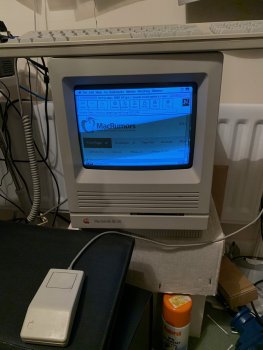This forum never fails to amaze me.
Got a tip for us?
Let us know
Become a MacRumors Supporter for $50/year with no ads, ability to filter front page stories, and private forums.
Load MacRumors on your oldest Mac
- Thread starter Appleuser201
- Start date
- Sort by reaction score
You are using an out of date browser. It may not display this or other websites correctly.
You should upgrade or use an alternative browser.
You should upgrade or use an alternative browser.
Packaging shows it to be a 1GB stick, sticker on it says it's 512MB, and system info shows it as 256MB lol.
1GB PC-133 would be exceptionally uncommon.
How many chips are on the stick? Macs capable of using 512mb PC-100/133 SD-RAM generally like to have 16 chips, and 8 chips is typical of SO-DIMMs in any capacity. With that said, I know I have some 8-chip 512mb ones kicking around-most likely in a TiBook.
I don't recall what I've done in Snow iBooks in the past, but am pretty sure I've had 512mb sticks working in them.
At one time, you could find "double length" SO-DIMMs that had two rows of chips on each side of the card, although I'm not even sure they will fit an iBook. A while back, I found some 16-chip ones on Ebay that used tiny chips and kept the same form factor as a standard SO-DIMM. I've used those in Lombards and the like where you historically would have used the double length SO-DIMMs.
1GB PC-133 would be exceptionally uncommon.
Really? I just checked on eBay and found quite a few but the prices are rather steep.
At one time, you could find "double length" SO-DIMMs that had two rows of chips on each side of the card, although I'm not even sure they will fit an iBook.
My first Wallstreet had one of those. I remember that it later became my first ever sale on eBay after I found a standard size sodimm with twice the RAM, which worked "unofficially". I think it sold within minutes of my listing it.
Really? I just checked on eBay and found quite a few but the prices are rather steep.
Which confirms their uncommonness. Kind of like 4GB DDR2 sticks.

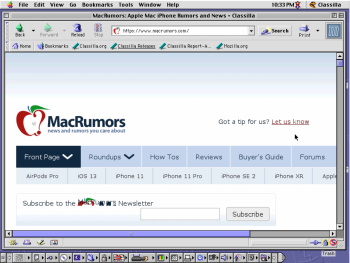
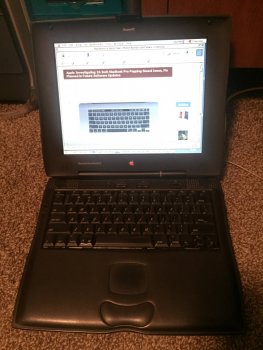
I had to jump through a couple hoops to get to here, but here is MacRumors (mostly without issues) running on my Wallstreet 233 MHz PowerBook G3! While not my oldest (My 8600/300 is slightly older, but getting Classilla to it would have been a little time consuming with my setup currently), it's from May 1998, so pretty old!
I had to copy the Classilla installer to another older Mac (my 10.5 Server held it), and then copy it to the Wallstreet in 10.2.8 (I realized later I could have done this from 9.2, but oh well).
Then I had to install it in Mac OS 9, and waited patiently for it to load the page. It gave a couple warnings about certificates, but it worked.
Then I tried to upload the screenshots after logging into MacRumors, but it didn't like the QuickDraw format that the built in Mac OS 9 offers (I could have put SnapzPro on here, but oh well again.
Then, I went over to my MacBook Air to change those QuickDraw formatted photos into .pngs, and here we are!
Maybe I'll try using the 8600 soon too! This was fun.
Is that a completely original unupgraded rev a/b iMac?! Those are hard to come by. How terrible does jaguar run? Funny, even OS9 needs more memory than 32mb.
1GB PC-133 would be exceptionally uncommon.
How many chips are on the stick? Macs capable of using 512mb PC-100/133 SD-RAM generally like to have 16 chips, and 8 chips is typical of SO-DIMMs in any capacity. With that said, I know I have some 8-chip 512mb ones kicking around-most likely in a TiBook.
I don't recall what I've done in Snow iBooks in the past, but am pretty sure I've had 512mb sticks working in them.
At one time, you could find "double length" SO-DIMMs that had two rows of chips on each side of the card, although I'm not even sure they will fit an iBook. A while back, I found some 16-chip ones on Ebay that used tiny chips and kept the same form factor as a standard SO-DIMM. I've used those in Lombards and the like where you historically would have used the double length SO-DIMMs.
Here it is, 8 chips on each side:

1GB PC-133 would be exceptionally uncommon.
How many chips are on the stick? Macs capable of using 512mb PC-100/133 SD-RAM generally like to have 16 chips, and 8 chips is typical of SO-DIMMs in any capacity. With that said, I know I have some 8-chip 512mb ones kicking around-most likely in a TiBook.
I don't recall what I've done in Snow iBooks in the past, but am pretty sure I've had 512mb sticks working in them.
At one time, you could find "double length" SO-DIMMs that had two rows of chips on each side of the card, although I'm not even sure they will fit an iBook. A while back, I found some 16-chip ones on Ebay that used tiny chips and kept the same form factor as a standard SO-DIMM. I've used those in Lombards and the like where you historically would have used the double length SO-DIMMs.
The 16-chip (half-size chips shaped as squares, 8-to-a-side) 512MB PC-133 (OEM, from my long-dead PB G4/400), which is now in my key lime iBook, consistently clocked slightly better in GeekBench than all the other PC-100 and PC-133 512MB SO-DIMMs I had lying about. I’m roughly 90 per cent sure it was supplied by Samsung.
Those double-length SO-DIMMs were typically used for ECC-registered enterprise routers and are all but likely too long to fit in iBooks (they definitely won’t in clamshells, as I measured!) and PowerBooks. Though there was one brand which produced a PC-100, ECC-registered 1GB SO-DIMM, it very unlikely cannot work in an SO-DIMM-equipped iBook/PowerBook, as there’s typically a parity chip involved.
Which confirms their uncommonness. Kind of like 4GB DDR2 sticks.
Several pages of results, albeit expensive, does not confirm rarity.
PowerBook G3 Wallstreet with the original 2GB disk. Jaguar is beyond terrible. Booting takes five minutes.Is that a completely original unupgraded rev a/b iMac?! Those are hard to come by. How terrible does jaguar run? Funny, even OS9 needs more memory than 32mb.
Last edited:
Several pages of results, albeit expensive, does not confirm rarity.
make sure your not getting registered and unregistered DIMMs confused
high capacity registered dimms of any type (PC DDR1 2 3 etc) are fairly common on ebay from old severs
but high capacity non registered sticks are very rare depending on exact type
make sure your not getting registered and unregistered DIMMs confused
high capacity registered dimms of any type (PC DDR1 2 3 etc) are fairly common on ebay from old severs
but high capacity non registered sticks are very rare depending on exact type
There were never non-registered 1GB PC-133/100/66 SO-DIMMs, were there?
Is that a completely original unupgraded rev a/b iMac?! Those are hard to come by.
Not really in my experience. Remember that when these came out, they were a hot item and sold like crazy-a lot to first time computer users. When you add in the fact they were not officially upgradeable by the end user, and even the unofficial upgrades are more complicated than your average home user would want to tackle, they're not terribly difficult to find in as-shipped configuration. Even if they've been upgraded, almost no end users would change the bottom DIMM since it involves removing the heatsink and CPU card, so if you do want to restore it to the original configuration it's generally a matter of popping the out the top DIMM.
Someone on here-I think maybe @MagicBoy -has talked about selling them new and doing in-store RAM upgrades. I remember him talking about changing a bottom DIMM back in the day and being terrified of it at the time.
Most of the G3 PowerBooks are along those same lines. The RAM is a lot easier to upgrade than an iMac G3, but they have the same top/bottom DIMM configuration(on either side of the CPU card) and many users would not have been comfortable with removing the card to access the bottom one.
There were never non-registered 1GB PC-133/100/66 SO-DIMMs, were there?
I think they DO exist, but are very rare/unusual and not many computers work with them
it would be interesting to get a couple to play with
You could give Web Rendering Proxy a try
Here:

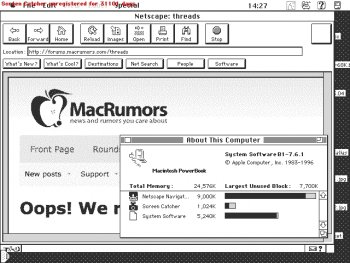
But we obviously "ran into some problems"...
Worked only once. Other tries made the proxy crash.
Last edited:
@galgot: Is there any chance of getting System 6.0.8 to run on the 150 and retrying this? 🙂
No chance I'm afraid, minimum system running on a 150 is 7.1.1
I have another one with 7.1.1, I might try with that one.
The Mac Classic can run 6.0.8, but at 8 Mhz and 4 MB of RAM, I doubt it would load.
Don't think there even is a browser running in 6.0.8.
Last time I've tried Maclynx in it, it cried for 7.0.1.
If you get the chance to, I'd love to see thisNo chance I'm afraid, minimum system running on a 150 is 7.1.1
I have another one with 7.1.1, I might try with that one.
http://macintoshgarden.org/apps/macwwwDon't think there even is a browser running in 6.0.8.
Missed that one !! something to try again
So…
I’ve tried with that 7.1.1 running 150, but it doesn’t work because that has only 4Mb of physical RAM. The poor HD scratches for 2mn trying to get some virtual memory before crashing. I’ll leave this one quiet…
Then I tried a PB100 booting 7.0.1 and 6.0.8, It reaches the page on 7.0.1 with MacWeb but can’t load the image.
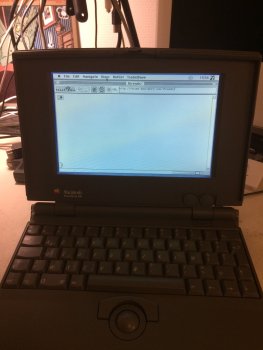
In 6.0.8, MacWWW just crashes after the splash screen :/ Anyways it runs at 16Mhz but with 4Mb RAM still only, Its a bit too optimistic. So forget the MacClassic at 8Mhz.
I was thinking a mighty SE/30 would maybe do, when mrod just posted
Not wanting to stop with a fail, I tried a PowerBook Duo 270c running 7.1.1.
We "ran into some problems" here too, but at least we have colors.

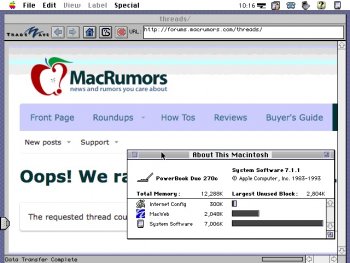
I’ve tried with that 7.1.1 running 150, but it doesn’t work because that has only 4Mb of physical RAM. The poor HD scratches for 2mn trying to get some virtual memory before crashing. I’ll leave this one quiet…
Then I tried a PB100 booting 7.0.1 and 6.0.8, It reaches the page on 7.0.1 with MacWeb but can’t load the image.

In 6.0.8, MacWWW just crashes after the splash screen :/ Anyways it runs at 16Mhz but with 4Mb RAM still only, Its a bit too optimistic. So forget the MacClassic at 8Mhz.
I was thinking a mighty SE/30 would maybe do, when mrod just posted
Not wanting to stop with a fail, I tried a PowerBook Duo 270c running 7.1.1.
We "ran into some problems" here too, but at least we have colors.


You could give Web Rendering Proxy a try
I found some free time to try this out, and while I can say it’s a nice idea, it’s still not very practical for real use. The transfer of data is pretty fast, but the poor little Mac plus takes forever to convert the image and put it onscreen. Even though it’s on a 5Mbps+ connection, we are still talking about measuring page load times in minutes, not seconds. In fact, this setup would probably have a hard time keeping up with a dial-up connection.
The way to enter a url is by using url parameters, so it’s pretty obtuse for the average user. Downloaded files end up on the server, and text fields don’t work in Mosaic, so there is no way to login remotely, however if you have already logged in through Chrome on the server and saved the credentials, it will just bypass that step anyway, but there is still no way to post in the forums😏 and a lot of the web doesn’t work with a B&W screen anymore.
You have to remember, 9” Macs only had 384 vertical pixels to work with, and part of that is consumed by the menu bar, and window chrome, so the banner ads on the top of most sites are taller than what’s left, and much scrolling is involved. Which means rendering more GIFs.
My credits to the author of WRP though, I have to say when I initially made the GIF and webpage for the plus I actually had the idea to make something similar. I guess you could say what I did was a manual web rendering proxy😜
The only thing that bothers me is it looks too good! The web would have never looked like this on this machine without WRP. Text formatting and layout is rather primitive in Mosaic, and since the page is actually rendered in Chrome on the mini, it doesn’t even use the classic system fonts. So I also saved the source of the MR home page and hosted it on my server to get a few shots of that too.
Register on MacRumors! This sidebar will go away, and you'll see fewer ads.





